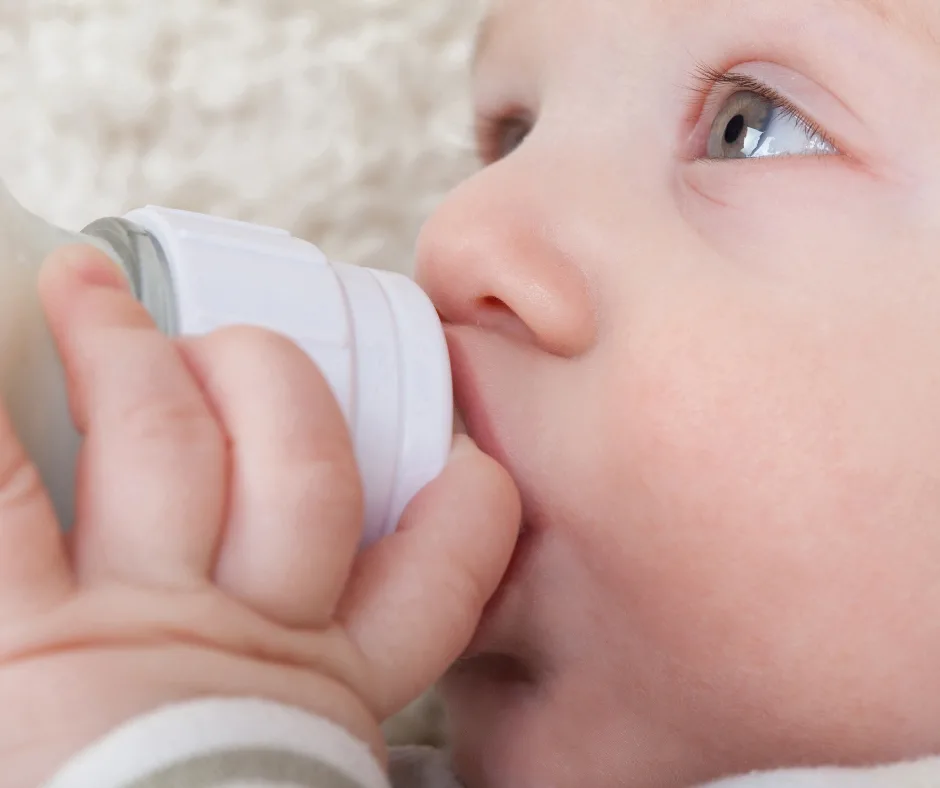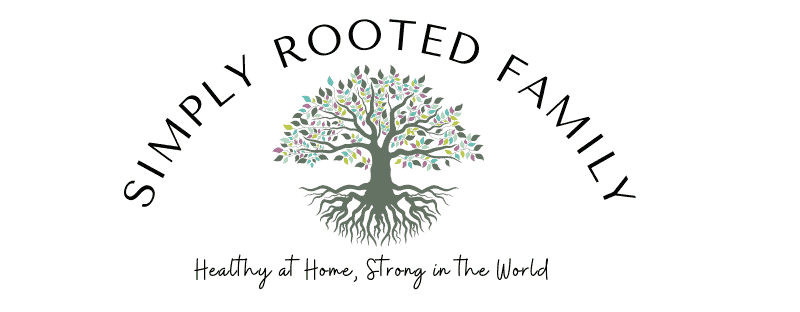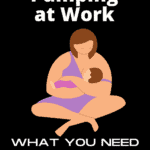First, I just wanted to say good job.
Breastfeeding is full of challenges, such as figuring out latching, fighting through those early days of pain, and constantly wondering if your baby is getting enough milk.
For some, these challenges persist, but you are tough and you stick it out. Some may resort to primarily pumping or eventually throwing in the towel, which is fine too.
For others, one day everything clicks and you feel so natural you can just imagine yourself sitting in a field of butterflies with flowers in your hair as you and your baby harmoniously bond.
As a breastfeeding mother of three, I returned to work 12 weeks after delivering my little ones, with laptop slung over one shoulder and breast-pump over the other. If you are a breastfeeding mother returning to work, you need to educate your self on your rights, what pumping gear you need, and potential challenges.

But Sir, It’s the Law!
Nowadays, most companies support pumping mothers. My company had a specific ‘pumping room’ for mothers, and was extremely supportive. However, if you don’t feel supported or you are being discriminated against, it is crucial that you know your rights!
All 50 states have some form of protection for public breastfeeding. In 2010, the Federal ‘Fair Labor Standards Act’ was amended to include verbiage that protects a woman’s right to express milk at work for one year after her child’s birth. Also, the law mandates that employers provide reasonable break time and a private lactation space that is not a bathroom. There are some exceptions (read your states law!), but basically by law you should have:
- A room to pump that is NOT A BATHROOM!
- Break time to pump
If you are asked to pump in a bathroom, or you are told you are not allowed to have a reasonable break to do this- you need to speak up!
The Pumping Mom’s Checklist
If you are prepared with the right pumping and boob gear, it will eliminate a lot of stress. I love pumping [said no mom ever!], but you made the choice to return to work (or the choice was made for you), and you are deciding to continue breastfeeding. Being prepared is super important for this transition! You will need the following items:
Breast Pump (duh!)
Unlike when I returned to work with my first, most insurances will cover a breastpump. [I had to dish out $150 for this stylish accessory below].
There are handheld manual pumps, ‘single boob’ pumps, and what I recommend, the Cadillac of pump, the ‘double boob’ pump.

I recommend the automatic pumps, that you can plug in and use. Many even come with battery packs for when you are pumping and there is no outlet around. This came in handy a few times for me when I had to pump at weddings or other events!
Using the double pump is fast and efficient, and great when you are at work and don’t want to spend 45 minutes in a pumping room! Additionally, some mother’s love the pumping bras that can allow for a hands-free experience (and might I add, are super sexy- joking!).

Pump Accessories
Your pump may come with all the parts (depending on the brand), but for some you need to purchase additional pieces. Or sometimes overtime these parts can get worn and you will need to buy extras. This can include:
- Breast shields
- Tubing
- Valves and membranes (note: these don’t look important, but don’t pull the membranes- or little plastic pieces- off like I did once because your pump won’t work!)

You may not need these immediately, but it is not a bad idea to stock up. I recall several nights where I had to make late night emergency stops at Walmart to pick up a replacement piece!
Milk Storage
You will need something to store the milk in after you pump. You have two options:
- Plastic storage bags
- Milk containers (make sure they are BPA-free)
If you choose bags, make sure you have the plastic ‘hook’ pieces shown below to attach your bags to your breast pump.
Someone the milk fat can stick to the side of the bags, follow these 7 tips how to get breast milk fat off the sides of the bag.
You may choose milk containers. Make sure to bring enough so that it does not overflow, and make sure you have a tight lid to avoid leaks. Ensure that the one you choose is made for your pump and can screw onto your breast pump shields. Also, you will need to get a cooler or store your milk properly in a fridge to avoid spoiling.
For Mom
We’ve all experienced the dreaded and unexpected leaks at home, the thought have that happening at work had terrified me! Stock up on some breast pads to stick in your bra just in case!

Bring a towel from home into the nursing rooms at work. It can get rather messy when you are in dress pants or work clothes trying to clean up milk leaks. Also, consider bringing in a magazine, book, or your cellphone. This can help pass the time while you are pumping!
What to Expect
As a breastfeeding mother, I have to say I did not LOVE pumping.
Having a cold plastic pump attached to me made me miss cuddling with my babies. However, in a way it made me feel connected to my baby still. Even though I was away, I was thinking about them constantly and doing what was best for the two of us even if it was the harder option! For best success, it is helpful to understand some potential challenges and what to expect.
Related: The Truth About Working Mom Guilt

How often and how long does it take?
Everyone is different, but I found that if I went any longer than 4 hours in between pumping I was uncomfortable. Also, the longer you go between pumps the more your body will ‘think’ milk is not needed and your supply will start to go down. I pumped every two to three hours, whenever possible.
Depending on your pump, the time it takes per session may vary. I was able to pump in 10 to 15 minutes. For some others, it may take much longer. You will quickly get a feel for how long and how often you need to pump.
Maintaining Milk Supply
Some women can pump for a long time and have no change in their milk supply. For me, my milk supply very slowly decreased overtime. For all three of my children, when they were around 8 months old, my milk supply dwindled to nothing. To avoid this, ensure you are pumping frequently. There are also some dietary supplements that claim to increase milk supply.

When my milk supply would dip, I would sometimes have to add formula and water to my breast milk to supplement and meet the babies needs. No biggie!
Milk Storage
Your milk supply depends on your babies needs, and how often they are eating. If you are pumping, it only makes sense that your body can’t always determine how much milk is needed. In the beginning, it is common to have more milk than is needed. You can always freeze milk in storage bags, glass containers, or BPA-free plastic containers for future use. Always write the date that you pumped on your storage bag. Depending on your storage method, your milk will have a different expiration ‘date’. I follow the “6 rule” to determine approximately how long the milk is good for:
- Stored at room temperature- around 6 hours
- Stored in refrigerator (preferably in the back)- up to 6 days
- Stored in a freezer- up to 6 months
If you thaw frozen milk, you typically want to use it within 24 hours.
Challenge of Pumping at Work
Everyone has their own unique breastfeeding testimonials, and I wanted to share two big challenges I had with pumping and going back to work in case anyone else experiences something similar.
First- not only did I love breastfeeding, my little ones loved it to. Even though I tried to introduce bottles to my children when they were a few weeks old, two of my children flat out refused a bottle when I went back to work. This was an extremely stressful time for me. In a full 8 hour day care day, for the first month or two, my baby would only drink ONE OUNCE all day!
When I first experienced this with my daughter, I felt all alone! I bought many 30 different types of bottles thinking “this will be the one she loves!’. After many tearful discussions with the pediatrician, I learned that it was NOT the bottle. Drinking from a bottle is much easier than drinking from the breast. The baby was just being stubborn. That was difficult to hear- that my 3 month old was already strong-willed! They assured me she would not starve, and sure enough she would want to breastfeed all evening long to make up for it! Quickly this passed and I learned of many other friends that had a similar experience!
Secondly, I had another super strange experience with pumping. All of my milk, even if I pumped hours before, started to smell sour and taste rancid. The babies didn’t notice, but everyone who smelled it did! It literally smelled like it rotted in the sun for a week!
I learned that this means you have too much of an enzyme, called lipase, in your milk. Lipase breaks down fat, and when you have too much lipase in your milk it causes the strange odor. It is not harmful to the baby, and if the baby notices it there is something you can do. You can ‘scald’ your milk- which means that you heat it over the oven. You do not bring it to a boil, but you want it to start bubbling slightly around the edges then remove it from the heat. I would have to do this as soon as I got home from work, before letting it cool and storing it in bottles for the next day.
You may also like: How to be a Calm Parent instead of a Reactive Parent
Final Thoughts on Pumping at Work
When you are a breastfeeding mother returning to work, there are new learning experiences for both you and your baby.
Pumping may come with a new list of challenges, but if you got this far with breast feeding then you are no doubt resilient and resourceful. You got this momma!
Are you returning to work? Did you have any other experiences? How did you overcome them! I’d love to hear about it!
For more tips on raising kids who are healthy at home and strong in the world, follow us on Facebook.


Rachel
Tuesday 18th of December 2018
I had no idea insurance could cover a pump?!great info, those lactation cookies are magic btw. I’m nursing my 4th baby, my goal is 12 months and those cookies have been a life saver for me!
admin
Wednesday 19th of December 2018
Wow!!! I wish I tried the cookies! I could never make it past 8 months. You go momma!!
Jun
Wednesday 28th of November 2018
I wish I knew all this when I was pumping and working. Great article with great products.
quijuana
Tuesday 27th of November 2018
I had my kids when insurance did not cover pumps, but I made the investment. Pumped with both my girls, the second one for one full year, and then nursed for a year after that. The best accessory I ever brought was the bra that you just stick the pumping cups so that I could still be hands-free. And yep, it's the law, and I've know companies to get in trouble for not accomodating, as they should.
Jenn
Monday 26th of November 2018
This is a problem I was lucky enough to never need to solve. So many people struggle with it though.
Heidi
Monday 26th of November 2018
You were very fortunate to be able to EBF. I admire that. It wasn't the case for me. I am so thankful to be Canadian and have access to a 12 month mat leave allowing me the time I needed to figure out how to feed my baby. I had to pump as well to try and boost supply. Unfortunately my insurance company did not cover my Madela machine :(